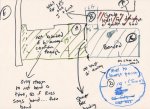I will have an AG pool (Intex now, permanent later) that will abut a soon-to-be-poured "sun deck" patio. It will also be close to a soon-to-be-poured patio under a cover. The sun deck and covered part are right next to each other. My question is:
1. if it were you, would you bond both? Or is it completely okay to just bond the sun deck since there will be a spacer/separator of some sort between them and since the pool will be six feet from the covered patio?
2. If you think it is okay to just bond the sun deck, can they pour the covered patio tomorrow and then come back to bond and pour the sun deck next week (when the electrician is first available)? In a recent post (in Pool bonding - Not so Good), I saw PoolGuyNJ write:
"NEC-2008 codes and later require the deck to have a conductive mat, either copper grid mesh or steel rebar, 3' out, regardless of the pool type or deck type. This mat must be attached in multiple places, usually 4 or more points, around the pool." . . . So, does that mean that to bond the sun deck, they'd need to put rebar 3' into the covered patio part? That would seem to defeat the separator suggested by my concrete guy and I think agreed to by my electrical codes people, but also, would mean they can't pour the covered patio as planned, tomorrow.
Here is a very rough diagram -- ignore most of the text. I would have them bond "B" and "C" and not "A" unless that either can't be done (ie, the 3' of rebar thing) or if people think even if code would allow that, I should go beyond and bond A. The green part (A) is the covered patio. The gray part (C) is the sun deck. The gray part in the corner (B) will likely be a third pour under the AC and near the electrical meter but this can't be done until my service line is replaced.
Please tell me what you would do if it were yours, not just what the minimum code requirement under the NEC is. My current Intex pool is exempt from bonding per our local codes, but our next, permanent AG will need to meet code. Regardless, I want to do what is wisest (without being needlessly over-done) to protect my family and friends.
1. if it were you, would you bond both? Or is it completely okay to just bond the sun deck since there will be a spacer/separator of some sort between them and since the pool will be six feet from the covered patio?
2. If you think it is okay to just bond the sun deck, can they pour the covered patio tomorrow and then come back to bond and pour the sun deck next week (when the electrician is first available)? In a recent post (in Pool bonding - Not so Good), I saw PoolGuyNJ write:
"NEC-2008 codes and later require the deck to have a conductive mat, either copper grid mesh or steel rebar, 3' out, regardless of the pool type or deck type. This mat must be attached in multiple places, usually 4 or more points, around the pool." . . . So, does that mean that to bond the sun deck, they'd need to put rebar 3' into the covered patio part? That would seem to defeat the separator suggested by my concrete guy and I think agreed to by my electrical codes people, but also, would mean they can't pour the covered patio as planned, tomorrow.
Here is a very rough diagram -- ignore most of the text. I would have them bond "B" and "C" and not "A" unless that either can't be done (ie, the 3' of rebar thing) or if people think even if code would allow that, I should go beyond and bond A. The green part (A) is the covered patio. The gray part (C) is the sun deck. The gray part in the corner (B) will likely be a third pour under the AC and near the electrical meter but this can't be done until my service line is replaced.
Please tell me what you would do if it were yours, not just what the minimum code requirement under the NEC is. My current Intex pool is exempt from bonding per our local codes, but our next, permanent AG will need to meet code. Regardless, I want to do what is wisest (without being needlessly over-done) to protect my family and friends.


